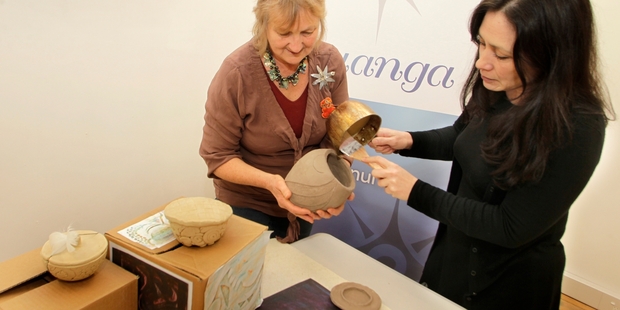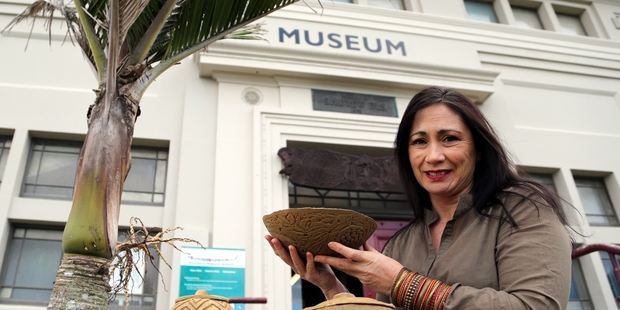Mallory graduating in her korowai that represents her whakapapa.
The main body is rooster feathers (teased to look like kiwi) and hard to see in this photo is the bottom of the cloak is kereru, peacock and pheasant in the style of the Gordon tartan to represent her fathers side.
I currently am finishing two other korowai and will do a proper photoshoot of them all once I get them done.
I had forgotten how long the process is and am working to specific dates so no time to stop for pretty photos!
Leonie Sharp
Leonie is an artist living in Whanganui New Zealand using feathers in contempory and traditional Maori weaving for exhibition and sale.
Tuesday, July 17, 2018
Sunday, July 9, 2017
Peoples Choice
The link below will take you to an online article and video about my recent "peoples choice award" at the Lysaght Watt Awards in Taranaki.
http://www.nzherald.co.nz/wanganui-chronicle/news/article.cfm?c_id=1503426&objectid=11876067
http://www.nzherald.co.nz/wanganui-chronicle/news/article.cfm?c_id=1503426&objectid=11876067
Wednesday, December 21, 2016
Te Kooti Series
The Te Kooti Series.
Many Māori movements adopted distinctive flags. This is Te Kooti’s war flag. The meaning of the symbols on it has been much debated. The letters ‘WI’ probably stood for the Holy Spirit, Wairua Tapu. The crescent moon was a tohu (portent) of a new world; the red cross was the fighting cross of the Archangel Michael, who appeared to Te Kooti in a vision in the 1850s. The moon and cross reiterate the first two elements of Te Wepu, a flag which Te Kooti captured from Ngāti Kahungunu in 1868.
It was subsequently captured from Te Kooti by Captain Gilbert Mair in 1870. Mair gifted it to Whanganui museum, which cut it up for use as dusters!This flag has particular significance to me as my iwi. Te Aitanga a Mahaki have a connection to Te Kooti through the Ringatu religion, and our home marae, Tapuihikatea, was built as one of four to further his teachings and welcome him back to Te Tai Rawhiti after his pardon.I am undertaking a series of works based on his imagery and images that I associate with his teachings and ideals and the universal nature of many of these images across cultures.
The Equal armed CrossEqual-Armed Cross, also referred to as the square cross, the balanced cross, and the peaceful cross, is a name for the Greek Cross when this is found in ancient cultures, predating Christianity.It is another universal symbol, which can be found in every culture with a knowledge of the passage of time.One of the simplest symbols, it represents several things to different cultures.The cross was a symbol to the ancient Celts representing the meeting place of the Divine energies (at the cross-section).In ancient Greece, the cross was an emblem of the four elements.To the Hopi Indians it is referred to as the “cosmic cross” with the four bars representing north, south, east & west correspond to the outermost points on the horizon where the sun passes through the yearIn the ancient Middle East, the symbol also represents the four directions (north, south, east, west) and the four winds.The cross is in this case actuality two separate signs-The vertical line symbolizes the path from earth to heaven and the realm of spirit.The horizontal axis, represents the path from birth to death, beginning to end, and linear time.
Primarily, the cross embodies the concept of unification between ethereal and material.
Billy Apple

Next year's Artists Open Studios has a couple of new features.
Firstly, the Trail Guide has been replaced with an art-centric catalogue of participating artists and their work. To make sure art is the focus, the organisers introduced a competition to choose a work to grace the cover of the catalogue.
At a function held last Tuesday evening, from 86 entries, the 12 finalists were announced, having been judged by a local panel.
"It took us about three hours to pick our 12 finalists," says Artists Open Studios co-ordinator Sarah Williams.
The winner, however, was chosen by a formidable artistic duo, imported for the occasion - Billy Apple and Adrian Hailwood - and they chose a work by Amy Fitzgerald.
I was honoured to be one of the 12 finalists and managed to get some time with art icon Billy Apple.

Tuesday, December 20, 2016
Friday, June 19, 2015
Kotahitanga
Kotahitanga
Literally the act of becoming one.
The Koru is often associated with nurturing so when interlocked with others is frequently used to represent the strength and purity of a loving relationship within a family. The design in the shape of two unfolding fern fronds, symbolize the bonding within a family or partnership with two opposite but complimentary life forces within an entity balance each other.As each frond unfolds to leave the circle, it reaches out for a new life, new growth and so the design also represents the cycle of life.
Wednesday, August 20, 2014
Page 4 this time!
Special vessels for new mothers
By Anne-Marie McDonald

About 30 ipu whenua will be blessed and gifted to the hospital this week.
The unfired clay containers were made by members of the public at a Puanga-Matariki workshop last month.
The ipu whenua are on display in the window of Gallery On Guyton. They must be completely dried and coated with beeswax before they can be used.
Workshop co-organiser Leonie Sharp said burying the whenua (placenta) in a vessel was a customary Maori practice, based on the belief human beings were first made from earth.
A person was said to be bound to a piece of land if their placenta had been buried there.
"Placentas were placed in hollowed-out gourds, wooden containers, flax containers, or uku [clay], which were anything from simple and functional to highly decorated or carved."
Wanganui Hospital's practice is to offer the placenta to each mother and, if they want to keep it, put it in two plastic bags and a brown paper bag.
Ms Sharp said she was delighted by the number of people who turned up for the workshop.
"I thought I might have been sitting there on my own, but we had a steady stream of people. We had a potter turn up, who helped out, but other than that it was a real mixture of people."
The ipu whenua are beautifully simple vessels. One has "made with love" written on the lid, another says "aroha" on the side, and most have decorations of feathers or clay patterns.
A few ipu taonga will also be gifted to the hospital. These are much smaller vessels, used when a woman has had a miscarriage.
Rena Star from Gallery On Guyton said the blessing and gifting would be held on August 22.
"We're going to invite the makers, members of the Puanga committee and museum staff to the gallery for a blessing, then we will give them to the hospital," Ms Star said.
The ipu whenua were a Puanga gift to the hospital.
"We do have some people who are interested in continuing the project on a regular basis, and we really hope that happens," she said.
By Anne-Marie McDonald
Saturday, July 12, 2014
Another Front Page!
Cultural containers to carry placentas
By anne-marie.mcdonald@wanganuichronicle.co.nz

Wanganui people are being invited to take part in a Puanga-Matariki workshop in making ipuwhenua - a vessel for holding the placenta.
At the Whanganui Regional Museum, artist Leonie Sharp will lead workshops next week in making the ipuwhenua to give to people at Wanganui Hospital and elsewhere. "They're very simple and made of unfired clay, so they can easily disintegrate in the ground," she said.
Ms Sharp said each ipuwhenua would take about an hour to make. Everyone was welcome to take part, and no previous experience in working with clay was needed.
The completed ipuwhenua will be donated to the Whanganui District Health Board as a Puanga gift.
A person was said to be bound to a piece of land if their placenta had been buried there.
"Placentas were placed in hollowed out gourds, wooden containers, flax containers, or uku (clay), which were anything from simple and functional to highly decorated or carved."
Although the practice nearly died out, it went through a revival in the 1980s, and was now supported by Maori midwives and some hospitals, she said.
Whanganui District Health Board's director of Maori health, Rowena Kui, said she anticipated the gifted ipuwhenua would be popular with women and their families. She said current practice was for hospital staff to ask a mother if she wanted to keep the placenta.
"If they do wish to keep it, the placenta is double-bagged in plastic and then placed into a brown paper bag and labelled. If women do not wish to keep the placenta it is disposed of appropriately by the hospital."
Mrs Kui said the ipuwhenua would be offered to all women giving birth, no matter what their cultural background.
Two other Puanga workshops will also be held next week.
On Tuesday at 1pm Rena Star will be teaching a drawing and cardboard print workshop, and on Wednesday at 1pm a mixed media craft workshop will be taught by Carmen Simmonds, Deanna Randell and Laurelle Lomas.
Ipuwhenua workshops will be held at the Whanganui Regional Museum from 1pm, July 18 and 19. All welcome.
Sunday, June 22, 2014
Latest Work.
IPU
An “Ipu” translates as a container or vessel, however, not just a physical vessel also metaphysical, the section of moko reserved for chiefs was ipurangi- the container of (Skyfather) Rangi’s knowledge.
Māori traditionally bury the placenta of a newborn baby in a special place, returning the whenua to (Earthmother) Papatuanuku. This was often done in vessels called ipu whenua, which were originally made from gourds.
Ipu Taonga literally means “a container or vessel for a treasure or precious item". In recent times these refer to the harakeke (flax) containers used for parents to transport very early miscarried babies for burial at home.
In this series I have played with the black/white balance both being visible as the ipu. The koru shape in the ipu denotes the treasure contained within.
I have again framed these pieces in stark white box frames to allow the natural feather colours to shine.
An Ipu Whenua workshop will be held on the 18th and 19th of July in conjunction with Puanga celebrations, please contact Whanganui Museum for more details or just donate some time to make clay pots to donate to your local midwives and hospitals.
An Ipu Whenua workshop will be held on the 18th and 19th of July in conjunction with Puanga celebrations, please contact Whanganui Museum for more details or just donate some time to make clay pots to donate to your local midwives and hospitals.
Christchurch Art Show 2014
Just home from the Christchurch Art Show, thank you to all of those who ran it, it was very successful and I met some great people.
The show was held at Wigram Air Museum.
Subscribe to:
Posts (Atom)








